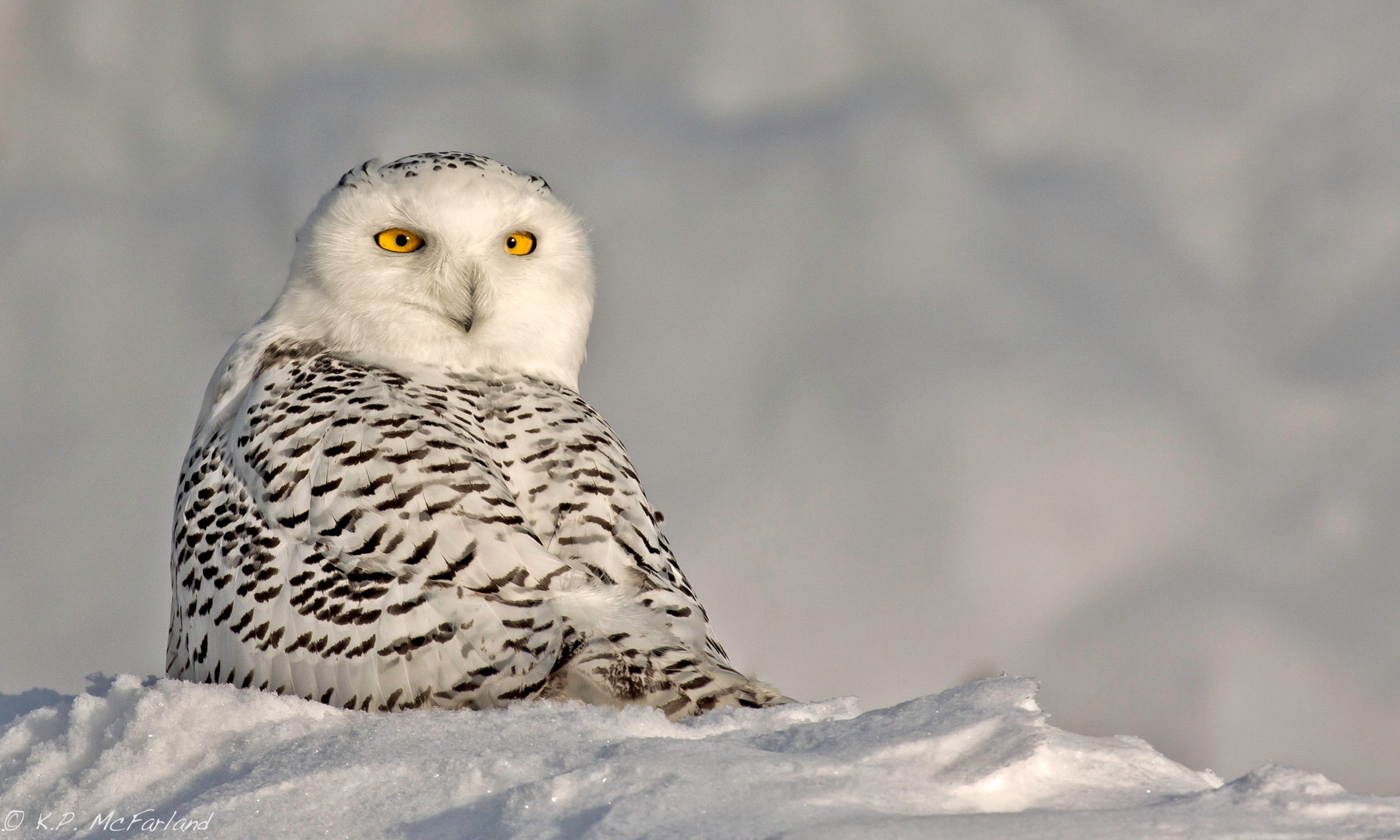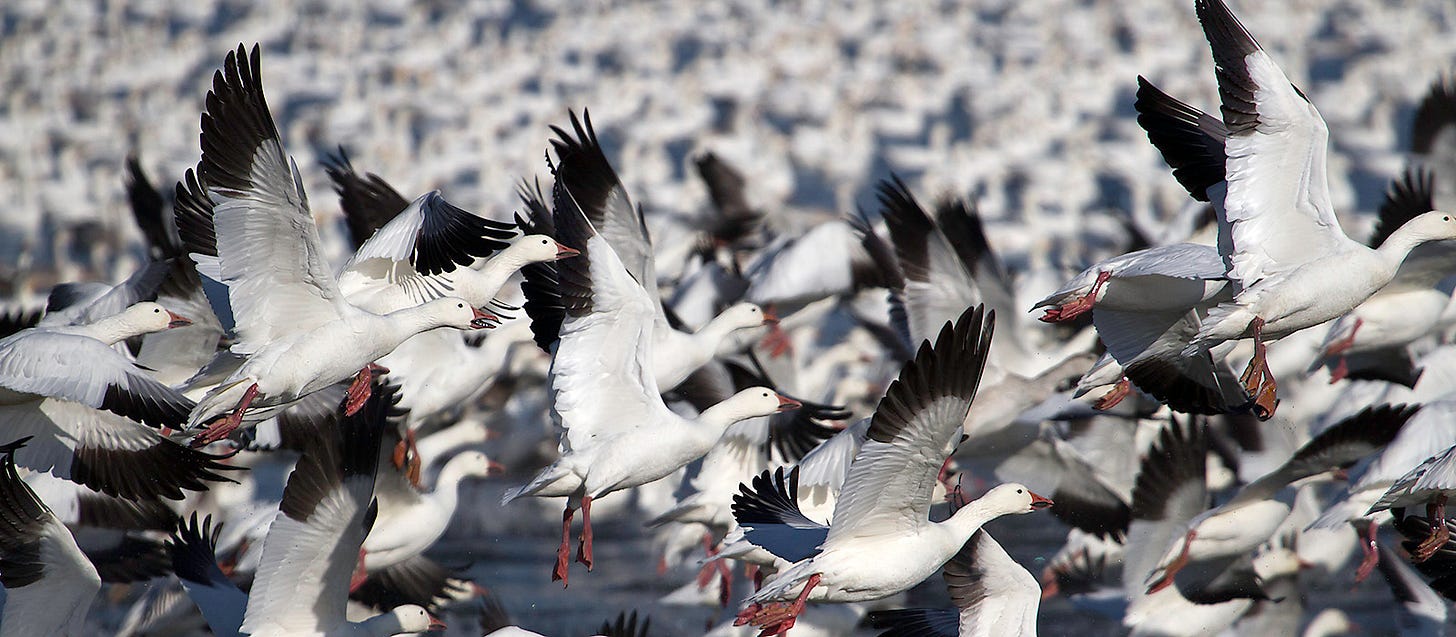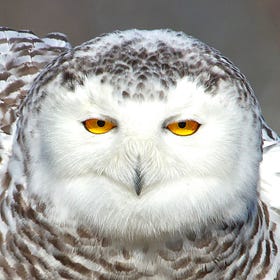ARCTIC FOXES will never leave their frozen tundra and saunter into Amsterdam or London. In no way will Snow Leopards stalk prey in the streets of Moscow or Delhi. And Polar Bears won’t be hunting around Boston or Seattle anytime soon.
But the Snowy Owls are coming. They’re coming for us — by which I mean for our benefit, especially those of us in Canada and the United States, where the white owls are just now beginning to show themselves.
With laser-yellow eyes, an indifference to the cold, and a fondness for open spaces, Snowy Owls come from vast Arctic landscapes most humans will never see — where the sun may never rise or set and where we ourselves would be among the tallest beasts standing against horizons so wide that they convey the curvature of Earth. The Arctic is what the owls unwittingly bring to us when they venture south and spend winter along our shorelines and runways, atop fenceposts and utility poles, on farm silos and even city rooftops.
I’ll be monitoring the whereabouts of Snowy Owls during their peregrinations into southern Canada, the U.S., and Europe this winter. And by way of gratitude, I’ll be helping paying subscribers to Chasing Nature find (with maps and other tools) Snowy Owls that might be spending the winter nearby.
The Snowy Owls’ arrival isn’t necessarily a sign that something is amiss where they live. To be sure, Arctic habitats are warming. But Snowy Owls were turning up south of their breeding range long before humans started baking the planet — as far south as Tennessee (3 Feb 1918), for example, California (1 Jan 1917), and east of Beijing (16 Dec 1916). Not a full-fledged migration, this dispersal is probably the way Snowy Owls have always gone about their business in winter. In some years they come south in huge numbers — an event ornithologists call an “irruption” (and the rest of us call unmitigated joy).
Rather than extreme cold, what mostly drives the owls south is food. One misconception is that Snowy Owls arrive to us emaciated and starving owing to lack of prey in the Arctic, mostly lemmings, voles, and other small mammals. As it turns out, the owls usually arrive in good health.
What’s more likely, particularly during owl irruptions, is that a boom in prey populations helps Snowy Owl adults produce more offspring that survive into fall and winter. If the lemmings then crash, for example, or if adult owls claim better winter feeding areas, some of the young owls head south in search of food — sometimes way south: San Francisco, for example, or even Bermuda. Indeed most of the owls that turn up in southern Canada, the U.S., and Europe are young of the year — displaying dark flecking rather than pure white feathers.
There is evidence that the Snowy Owl is a species in decline (Rosenberg 2016) in parts of its circumpolar distribution. But because these birds live so remotely, and are therefore difficult to study, population estimates and trends are notoriously hard to develop. We have much to learn about this iconic animal, and yet so much to discover for ourselves as we visit with Snowy Owls closer to home this winter.
New Perks for Paying Subscribers
I’ll have more to report about Snowy Owls as more of them turn up over the course of winter. For now, however, here’s some developing news: As I approach my one-year anniversary on Substack, I’m creating new opportunities for us to experience more actual nature — a portal here on Chasing Nature with resources for paying subscribers. Called “Go Wild,” it includes:
Insider advice and maps to help you find some of the wild things I write about — Snow Geese and Snowy Owls, for example, or moths still flying around and mating in the cold (next month).
A “Classroom” where subscribers can watch my video lectures and seminars on everything from nature photography to birdwatching (and perhaps writing strategies).
A place online where Chasing Nature’s community of paying subscribers can post photos of what they’re seeing, and where experts (me and others) can then help with identifications.
An index to my essays, organized by ideas (climate or extinction, for example) and by taxon (birds, butterflies, mammals, mollusks, etc.).
The other breaking news is that in the spring of 2024 I’ll be teaching (here in Vermont) a short field seminar on butterfly identification and biology. (Yep, we’ll run around outside together with insect nets.) If you can’t attend in person, Chasing Nature’s paying subscribers (at the yearly rate of $50) will get online access to course materials and lectures. I’ll do this with other seminars I might offer as well — on dragonflies, for example, or moth photography.
Oh, one other thing: Gulls. Yeah, gulls — some of the most audacious animals on Earth. Gulls will change your life. So, timed for when many of us get out into winter in order to chase gulls, our Classroom, once it’s launched, will feature my “Getting Gulls” lecture. So prepare to become “gullable.”
Snowy Owl and Snow Goose Mini-Update
Snowy Owls are just now beginning to show up in the American Midwest and a few Canadian provinces. In the U.S., that includes Montrose Beach Dunes in Chicago, the “thumb” of Michigan, and a couple spots in Minnesota. In Canada this past week, Snowys turned up in Ontario north of Toronto; not too far from Winnipeg, Manitoba; and in Saskatchewan and Alberta. The first New England Snowy Owls are due any day now. I’ll keep you posted (including more details to come in the Go Wild portal).
Meanwhile, for my readers in New England and upstate New York, we’re at or near “peak goose” in the autumn migration of Snow Geese through the Champlain Valley. In New York, check out the fields and lake around King Bay just southeast of the village of Champlain, where upwards of 6,000 Snow Geese have been reported in the past week. And goose counts at Dead Creek Wildlife Management Area in Addison, Vermont, were as high as 1,500 in the past few days. These numbers should hold or increase a bit over the next week or two.
Finally, here’s more of what it’s like to experience a Snowy Owl — my inaugural dispatch on Chasing Nature (adapted from an essay I wrote for Aeon magazine).
Arctic Owls on a Warming Planet
PERCHED ON A ROCKY POINT along the coast of Maine, the Snowy Owl is languid, indifferent, a predator without country. The wind and cold and crashing waves do not matter. You do not matter. The Snowy Owl cares not that you have driven halfway across winter to witness a white bird alone on the headlands.
Even if you don’t avail yourself of these upcoming perks, your paid subscription keeps me employed writing these essays for you every week or so, and keeps Chasing Nature available to everyone. Thanks!
References and Postscript
Holt, D. W., M. D. Larson, N. Smith, D. L. Evans, and D. F. Parmelee. 2020. Snowy Owl (Bubo scandiacus), version 1.0. In Birds of the World (S. M. Billerman, Editor). Cornell Lab of Ornithology, Ithaca, NY, USA. https://doi.org/10.2173/bow.snoowl1.01
Rosenberg, K. V., Kennedy, J. A., Dettmers, R., and others. 2016. Partners in Flight Landbird Conservation Plan: 2016 Revision for Canada and Continental United States. Partners in Flight Science Committee. http://www.partnersinflight.org/wp-content/uploads/2016/08/pif-continental-plan-final-spread-single.pdf
I am ever-grateful to my friend and brilliant colleague Kent McFarland, whose Snowy Owl image above is better than any I myself have ever captured.








I egretly await my tern to duck tradition and become more gullable. Herring these parts, there aren’t too many, but murre than many realize. Owl also be perched by the window, where snowy precipitation of joy might be expected, and I’ll likely grouse if only juncos show.
“From a Snowy Owl’s eyes the Arctic speaks. Hypnotic and seductive, like bioluminescence or romance, the glow brings you immediate and ancient pleasure. From the intensity of this gaze you cannot look away. And yet from the owl there is no reciprocity. “
Hours spent creeping silently through the trees at the very edge of the forest line. Across the long expanse of a field , taking turn back and forth between squinting and binoculars.
Finally what looks to be a snowball on top an old fence post.
A whisper, Shhh… there it is.
Don’t even breathe , it will hear us .
We think we are so stealth .
Of course it knows we are here.
Finally , for just one moment we get a piercing yellow glance that says ‘you’re boring me’.
We sit breathless, like the end of the grand finale of an incredible fireworks display.
There has never been words to describe the feeling of making eye contact with such a magnificent bird .
Until now.
Thank you Brian ,
The whole post, just perfection !
Can’t wait to head out and pretend I am as quiet as the tiny prey it’s stalking.